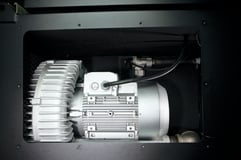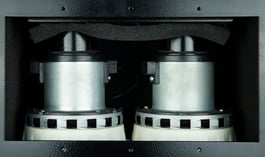Fume extraction systems are designed to help you, which also requires you take care of them. Maintenance is a simple, yet important part of keeping your fume extraction systems running at their optimal performance level. Whether you have a portable or large stationary fume system, the maintenance is manageable and necessary. These different systems require their own specific attention, but ultimately use the same maintenance checklist.
For optimal performance and the best return on your investment, you want your system to operate the way it was designed to perform. In order to do this, maintenance has to be routinely completed on your system. Most ventilation companies offer you a maintenance checklist, which for most people will make this process easier and understandable. Just like a checklist, we will detail some of the required maintenance in the order we find will be most effective for your equipment.
Dust Tray
Depending on the type of fume extraction system you have, you will need to empty the dust tray on a daily, weekly, or monthly basis. The dust tray collects particles from the extracted fumes, as well as other particles that are in the air. You will need to empty the dust tray to ensure build-up does not occur. Overloaded dust bins can cause filter damage and excessive wear on the system as a whole. For a smaller system, you will want to check the dust bin daily or weekly due to the size. The bigger systems can go a little longer without a clean-out, but will require a check at least once a month. You will have to monitor according to your process and how often your systems are being utilized.
/Blog%20Photos/Fume%20Maintenance/Dust_Tray.png?width=299&name=Dust_Tray.png)
Filter
Another important part of the system that will require routine maintenance is the filter. With some of the fume extraction systems, there is a small light that turns on if the differential pressure is too high in the system.
/Blog%20Photos/Fume%20Maintenance/Filters.png?width=250&name=Filters.png)
/Blog%20Photos/Fume%20Maintenance/Exhaust_Filter.png?width=218&name=Exhaust_Filter.png)
If the differential pressure is high, that means your filter is full of dust. A filter change could be necessary, but you can also clean the filter to bring it back to its original state. Taking care of the filter is a necessity. On a bigger system, you can check the differential pressure directly on the machine. For a small portable fume extraction system, you likely will not have a differential pressure reader. You will have to pay attention to the light on the machine that will turn on when maintenance is required. Keeping a good filter is key for optimal performance. If your filter is full, it will force the motors into a less efficient state and will at one point reduce the flow so much that there will no longer be significant extraction.
Compressed Air
Going along with filter maintenance is compressed air. Dry and clean compressed air is used to clean the filters with different devices depending on the system you're using. If your compressed air is wet or oily, leaking, or does not have the proper pressure and flow going to your filter cleaning device, you will not get optimal performance from your filter. Compressed air is key to the maintenance and long time use of the filter.
Seals and Gaskets
After you've checked on all of these parts, look at your door seal and gaskets for leaks. There is nothing worse than a leak on the system. This issue will reduce performance and increase the wear on the entire equipment. Imagine there's a leak right near the source of the vacuum, this will extract air from that point rather than the point you want. Whether it's a hood, MIG torch, or robotic operation, you need your systems to be fully sealed. Every time you open the door to do routine checks, like emptying the dust tray or checking the filter status, it's important that you close it tight and verify all gaskets and seals are shut. Leaks are the last thing you want your fume extraction system to have, so take the time to make sure there are none.
As we talk about leaks, we can discuss the inspection of hoses or the duct system. You want to spend energy on the vacuum and filtration, not wasting energy on leaks. You would be surprised by the amount of flow that can go through a small leak. It is critical to inspect the duct work of your system routinely. Ultimately, you want to bring your moving air to the extraction zone. If you are using permanent ducts, a regular check is adequate. If you are using hoses, especially those that are lying on the ground or going throughout the welding site, you will need to check these more often because they may be damaged much quicker. The same goes for using a MIG torch with an extraction system. Take care of your equipment.
Motor
Lastly, let's check the motor. The motor is the heart of the system. You want to make sure that it is clean from dust and that the cooling holes or fins are free of debris. The motors job is to take the circulating air and move it very fast to create the vacuum. A part of the energy used during this encounter will dissipate in the form of heat generated by the process. If you do not have proper maintenance for the cooling mechanisms or if you do not clean the outside of the fins on the bigger motors, it will not cool properly.


If the motor is kept warmer than it is supposed to be, you will reduce the performance level while increasing wear and decreasing the time allotted until your next replacement. If your system has a small cooling fan on top of the motor, it is necessary to keep the air flowing freely around it for natural heat dissipation. Other than this, your biggest maintenance red flag will be vibration or noises coming from your motor. If you notice uncommon noises or stronger vibration, it's a clear sign that maintenance needs to be done. Letting this go will, very soon, wear the components that make up your fume extraction system. Inside the vacuum the contents are spinning, therefore if something is off balance you take a chance on having to deal with unplanned shutdown or expensive repairs.
In Review
Your fume extraction system will work hard to keep your facility clean. Completing this checklist of basic maintenance needs will keep your fume systems running and operating optimally. This list should be used as a starter as additional maintenance can always arise. You will grow to know your system and should pay close attention to when something seems off. This routine maintenance will vary depending on the fume extraction system you have in your facility, but nonetheless is a great starting point for all.
--
Ready to go deeper into fume extraction? Our eBook, The Complete Guide to Fume Extraction, is as deep and detailed a look into source capture fume extraction you will find. No form fills to read. Just click to get started.


